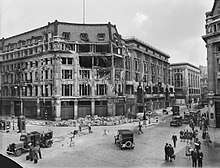Peter Robinson (department store)

Peter Robinson was a chain of department stores with its flagship store being situated at Oxford Circus, London. Founded in 1833 as a drapery, Robinson bought up nearby shops on Oxford Street to create a department store. The shop building in Oxford Circus was completed in 1912 and is Grade II listed.
History
Peter Robinson (1804–74) opened a drapery on Oxford Street in 1833. By 1840, he had opened a mourning store at 250–264 Regent Street,[1] and increased his store space in Oxford Street by buying up nearby shops, so by 1850 he was able to create a department store which was known for selling fashionable ladies clothes and accessories.[2]
During the 1850s John Lewis, the famous store founder, worked for Peter Robinson,[3] initially as a drapery assistant, but worked his way up to being the youngest silk buyer in London. In 1864 he was offered a partnership in the business, but declined; instead he opened his own drapery on Oxford Street.[4] Peter Robinson, the founder is buried in Highgate Cemetery.
The current building at Oxford Circus was designed by architect Henry Tanner. Being completed in 1912, it is Grade II listed.[5] The building was substantially extended in 1923.[6]
The business grew into a small chain of department stores and in 1946, Burtons (now Arcadia Group) took over the chain. The business continued to expand, with new stores opening across the United Kingdom, including Lime Street in Liverpool. Anglia Television televised the opening of the Peter Robinson Store in Hay Hill (still a Topshop).[7] At the height of the business Peter Robinson had 39 stores.
In 1964, to try and attract the younger buyer, Peter Robinson's Topshop was opened on the third floor of the Sheffield store (located in Angel Place, now Primark).[8] In 1965, the basement of the Oxford Circus store was converted to be a Peter Robinson Topshop.
In 1974, Burton's Group, the parent company decided that Peter Robinson and Topshop should be separated, with Peter Robinson aiming for the over 25s. The number of stores reduce from 22 to just 6. By the end of the 1970s Peter Robinson brand had all but disappeared.
References
- ↑ "These Pair of Black Peter Robinson Gentlemans Shoes Mid 19th Century, Poppies Cottage website". Retrieved 3 Nov 2014.
- ↑ "Peter Robinson". Retrieved 3 Nov 2014.
- ↑ stores "Explore 20th Century London" Check
|url=value (help). Retrieved 3 Nov 2014. - ↑ "From Drapers Apprentice to Global Empire Builder, Manchester Evening News". Retrieved 3 Nov 2014.
- ↑ "New Markets, English Heritage website". Retrieved 3 Nov 2014.
- ↑ "Getty Images". Retrieved 3 Nov 2014.
- ↑ "Anglia Television broadcast, UEA website". Retrieved 3 Nov 2014.
- ↑ "Topshop : A History, Lippy Mag". Retrieved 3 Nov 2014.
Coordinates: 51°30′55.95″N 0°8′30.12″W / 51.5155417°N 0.1417000°W